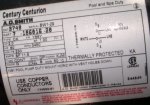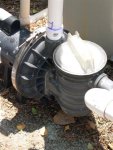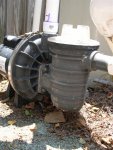I think I'm starting to get it, sort of

mas985 said:
The actual performance of a pump head curve is due to the wet end. A motor is simply sized to the wet end load. The problem with using just the SFHP rating of the motor is that pumps can have much different head curves but use the same size motor so it isn't always a good indicator.
I interpret this to mean that the pump, not the motor, determines the gpm flow rate. This flow rate is important to know because it is what we use to determine appropriate filter size. Do I understand this correctly?
Yes
Further, pumps are designed to hold a specific hp motor, this is where the “1 hp pump†comes from. I now have a 2 hp motor on my pump- this may or may not be what it was designed for. Thus, I may or may not have a 2hp pump (and its associated flow rate).
More or less. Pumps are designed around available motor sizes. Normally, you will see motors sold in 1/2 HP increments with certain service factors. So a pump designer will make sure that the design comes close but below one of those increments since it would be very costly to then design a new motor for just a single pump design.
Now, the energy usage comes from the motor, yes? If I use the AO Smith calculator for my motor is that an accurate representation of my usage- or does the pump affect the amount of kwh it pulls somehow? Understanding this helps to know what type of affect, energy wise, a new pump would have.
Yes and no. The impeller creates a load (energy required) which is transfered to the motor. The motor then draws enough current to move that load at near 3450 RPM. So really, the impeller and motor efficiency determines the amount of current draw and thus power. This is why you can change out just the impeller to a smaller size which will reduce current draw and power consumption of the existing motor. This is a very cost effective way to downsize a pump. Impellers are usually less than $50 although on some pumps you also will need to change the diffusor so it can be a bit more.
However, motor efficiency comes into play as well. Higher HP motors have higher efficiency because the winding gauge is thicker to handle the higher current so lower I2R losses. But if you underdrive a motor, efficiency drops some because of the inductive fields but it started higher to begin with so net net, the power draw for two different HP motors is about the same for the same impeller at least within a few percent.
Also, since the impeller load changes depending on the operating point of the head curve, the current draw on the motor will also change with the operating point. Plumbing with higher head loss has lower current draw because flow rates are lower. Low head loss plumbing draws more current but the gallons/watt-hr are higher for low head loss plumbing which is why that is desireable.
I spoke to Sta-Rite this morning trying to determine which model I have, with no luck. Is there a way you are aware of that I could determine which model (and therefore hp) I have? Maybe something different between the different models that would help narrow it down?
As I posted earlier, I believe you have a P2RA6G-183L 2 HP Dura-Glas pump. The filter pressure confirms that. My point earlier is that not all 2 HP pumps have the same head curves so they will perform different and consume different amounts of energy although they will be close. In order to predict the performance of a pump on a plumbing system you have to know what the head curve looks like so knowing just the motor size is not enough you need the model # of the pump. Normally, someone will not put a higher HP motor on a pump than needed. However, they might reduce the size of the impeller. But again, the filter pressure is consistent with a 2 HP pump.
They did mention that air intrusion (which I have) is a sign of an oversized motor. I realize it could be due to several other causes, but with the motor having been replaced I suspect I ended up with an oversized motor.
I think they must have meant an oversized pump. A lot of people use pump and motor interchangeably but they are really different. Oversizing the motor has absolutely no effect on the wet end. However, an oversized pump will have flow rates and head loss which may be too high for the plumbing and will create high suction and draw in air.
Looking at my system, I have different components replaced at different times by different companies. I think the pump is original, the filter in ’94 (I think it was originally cartridge), and the pump motor in ’02-03. Good chance none of it is all rated to work together, I’m starting to suspect I may need to just start over.
Another thought. The flow rates you posted in your last post are based on the pump being a 2hp pump, yes? So, if my pump is really a 1hp pump (for example) then the flow rates would be less, right?




